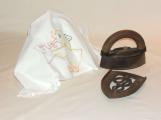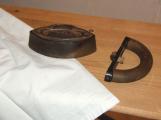1
Ironing Day
1920's
Saskatchewan, Canada
 Credits:
Credits:
Assiniboia Museum
2
After the daily chores were completed the homemaker began ironing the Monday's laundered clothing. This was an era of no synthetic fabric therefore most of the clothing had to be ironed.
3
Ironing Board
1920's
Saskatchewan, Canada
 Credits:
Credits:
Assiniboia Museum
4
The now slightly moistened clothes were usually prepared after they were dried on laundry day were now ready for ironing. If no ironing board was available, one ironed on the table using several layer of blanketing topped by a smooth sheet remnant. This was how young girls learned how to iron, first starting with pillowcases, etc. on a large flat surface. Ironing board priced at $3.35.
5
Sad Irons on Stove
1920's
Saskatchewan, Canada
 Credits:
Credits:
Assiniboia Museum
6
Three numbered sad irons were placed on the hot portion of the stove (over the fire box). It was the heat and the weight that was essential. They were numbered, so one knew, which would be the next iron to use once the current one had cooled down.
The word 'sad' in this context is English for heavy or dense.
7
Iron and Wooden Handle
1920's
Saskatchewan, Canada
 Credits:
Credits:
Assiniboia Museum
8
Sad irons were invented in 1870 by Mary F. Potts of Iowa USA. This was an improvement in that they stayed hot for a longer time (due to the thickness of the object). There was a wooden handle replaced the metal one to prevent burning one's hand. The set of three irons and the stand was $2.25.
9
Sleeve Ironing Board
1920's
Saskatchewan, Canada
 Credits:
Credits:
Assiniboia Museum
10
There was an art to iron clothes i.e. a man's good shirt - one started with front and back yokes, the sleeves then the body of the article. With the use of the special sleeve ironing board one could succeed to have well ironed sleeves - one without a centre crease.
11
Asbestos Sad Iron
1920's
Saskatchewan, Canada
 Credits:
Credits:
Assiniboia Museum
12
The evolution of irons came about with different types of sad irons and the invention of the charcoal irons, and gas irons. This heavy iron at left has "Asbestos Sad Iron" embossed on the top. The metal cover with wooden handle would be placed over top of iron and be locked in.
13
Gas Irons
1920's
Saskatchewan, Canada
 Credits:
Credits:
Assiniboia Museum
14
The gas iron was a boon as now the heat could be regulated. A valve at the base of the iron regulated the amount of fuel fed to the burner. Then one set a match in the opening to start the fire. There could be incidences of high flames, singed handle/hands, or an explosion. The homemaker found the gas iron practical especially in the summer - no need to heat the stove as with sad irons.






